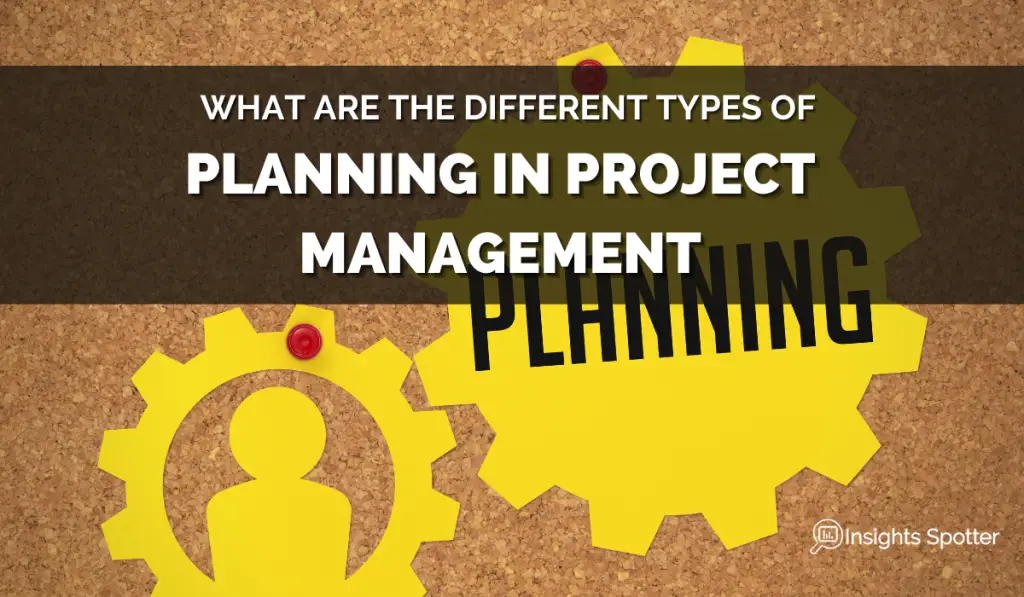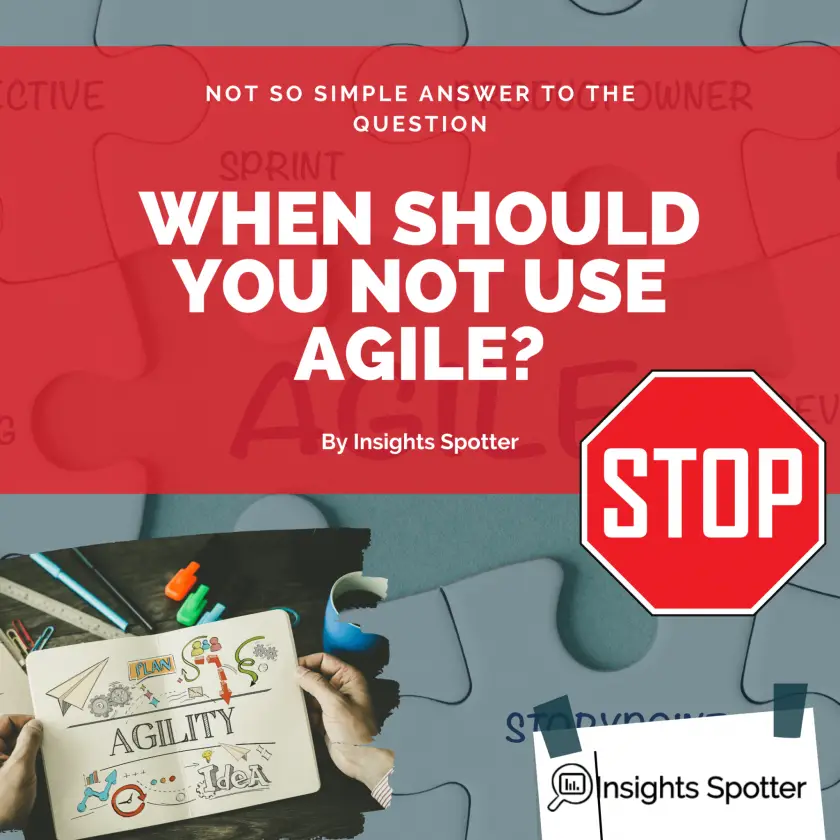When Should You Not Use Agile?
The Agile manifesto has literally changed the project world regardless if your organisation is using Agile or not. Still, should you use Agile in your project or organisation? What are the indicators where we should be avoiding it?
Some projects or environments are not suited for Agile frameworks. For example, Scrum has prescribed methods that require business dedication and investment. Still, Agile as a mindset with values and principles can be used by any initiative as it promotes collaboration, working solution and improvements.
Thus, there is a difference between values Agile is promoting and frameworks used to implement an Agile mindset.
You might have decided to start using it or just discussing if Agile is something that your organisation should implement. You probably have heard where Agile is applied the most: the technology industry, apps, software, etc. However, projects can use it with process-driven projects as well. So, it is not a question of whether you can only use Agile with products or technology projects.
Further in the post, we will understand in what situations Agile frameworks are not a great fit for the project or business. We will explore “red flags” in the company’s culture or projects’ types that you might undertake?
What Is Agile?
Let’s start our journey with understanding Agile first. As mentioned above, Agile is not the same as Scrum, Kanban or XP frameworks. If you would like to learn more about Kanban or Scrum, check out these three post:
- WHAT IS THE DIFFERENCE BETWEEN SPRINT AND SCRUM?
- CAN KANBAN HAVE SPRINTS? SIMPLE ANSWER
- DOES KANBAN HAVE A PRODUCT OWNER? SIMPLE ANSWER
What Is Part Of Agile Manifesto?
Agile represents a methodology or state of mind, which comes from the Agile manifesto. The ideas behind this are that the initiative or product have their requirements or solutions that emerged through a collaboration of self-organised cross-functional teams. Plus, agile aims to provide valuable solutions that should be complete after each update and bring value to the customer or business. Finally, Agile ideas seek to react to changes in markets, customer and business needs and prioritise change rather than blindly following the plan. You could potentially agree that having this mindset in any project would bring more value to final users.
Is Agile Different From Scrum Or Kanban?
We should not confuse the Agile methodology with Scrum and Kanban (being the two popular) frameworks. The framework has tools and roles that help implement practically an Agile mindset in the business. Although Kanban and Scrum are using the same methodologies, both have different tools, roles and rituals suited to various business situations.
For example, Kanban is more suited for business service type of initiatives with varied priorities. You can read more about several differences in my blog post: CAN KANBAN HAVE SPRINTS? SIMPLE ANSWER
Now, let’s look into four categories I used to group “red flags”, indicating if Agile might not be the best framework for the job and more investigation is needed. The groups are:
- Business Culture
- Business Operating Conditions
- Customer Behaviour
- Project Type

What Cultural Factors Prevent Agile Implementation?
1. Low Management Or Customer Confidence In Teams
Does Management Or Customer Do Not Like To Relinquish Control?
As we have seen before, we would like to have self-organised teams, making priority calls and actively looking for the best way forward. Yet, suppose either your management and/or customer do not like to lose control, preferring highly controlling top-down management. In that case, teams will likely not receive enough autonomy and have low trust for implementing Agile ideas. All initiatives will have to go through slow approval and bureaucratic processes that are not aligned with anything Agile promotes. So, why you even bother to call it Agile.
Does Management Believe Agile Values Aligned With The Business?
Furthermore, suppose management doesn’t feel that Agile values are aligned with the way the organisation currently operates. In that case, the team will not be allowed to carry forward with a new framework. All the efforts to move away from the standard Waterfall type projects will meet resistance. Therefore, the team, who wants to use Agile, would need to ensure that management is on the same page with the new framework.
Is Management Prepared To Invest In Agile Training?
Linking well with previous “red flag”, if your organisation doesn’t see a future or benefits in Agile. Therefore, management will provide little investment in further developing a wider team, and you cannot have two different groups, like development and project management, using other frameworks. A lot is about speaking the same language in new frameworks. Without shared understanding, the team will not be productive and benefit from selecting its standard business framework.
2. Team Is Not Willing To Use Agile
Do Teams Ready To Collaborate?
We saw how top-down influences are essential. Now we will look at the bottom-up. To implement Agile, you need teams collaborating regularly and sharing ideas, solutions and workloads. Without the team being on board, even if management tries to implement Agile, it might be challenging to get to a productive working environment. So, we have bottom-up influences of changing work frameworks as well.
In many organisational cultures, people try to protect their information because they think they will not be relevant without it, and knowledge makes them powerful. Given that we live in the information/data age, regardless if you are implementing Agile or not, this is already detrimental to a business. You will end up with politics and not progress. One of the fundamental features of Agile is for a team to work together, share experiences and ensure that the whole team is delivering. Hence, an organisation should start by encouraging to collaborate and remove obstacles.
Are Leaders Ready To Transition To Different Roles?
The other reason team members might be resisting Agile is that it brings a more flat structure. There are fewer managers more collaborator with different skills sets. Scrum, one of Agile’s frameworks, have a product master and product owner as something necessary to implement the framework. But that means that current managers may have different roles, or their roles will become irrelevant. Therefore, if they feel frightened personally, they might try to hinder change. A business should work with them to successfully transition to a similar level role in new frameworks; otherwise, it may be necessary to introduce new leaders.
Can Your Business Teams Become Self-Organised?
Finally, often teams in traditionally managed organisations are not used to be self-organised. They might be waiting for a steer from the top before any action is being taken. You know that culture where you are afraid to make a decision. If your individual decision is right, you keep a job if bad; who knows what may happen.
In such an organisation, everyone tends to avoid taking action and always looking at how to cover their bottoms. Taking action is required if you need teams to self-organise work and deliverables. Having an excellent operating model is essential but having a culture with a lot of back covering means everyone needs to get 100 approvals before proceeding.
3. Agile Is A Poster Child But Not Embedded In Business Culture
Do You Actually Need Agile In Your Business?
You will get businesses that are thirsty for innovation. The way they are trying to achieve that is through restructures, changing processes and working frameworks. The original business process might work perfectly fine for the business, and implementing Agile would be just a distraction.
The worst thing here is that business leaders might think that just advertising or implementing Agile things will change, and people will start to be innovative. The approach is likely to fail or be sub-optimal. As we saw before, an organisation should start changing the culture and gain support at all organisation levels before shouting that they have Agile from the rooftops. Agile is a mindset and not a tool.
Should You Advertise Agile In The Hiring Process?
On some occasions, a business may even look to attract new people by advertising as Agile. Yet, as with any lie, eventually, things come forward, and situations are usually worse than before. Hired people realise that the working environment is different and leave or are much less productive and unhappy.
Thus, the organisation should avoid throwing Agile if they do not actually have the culture, necessary environments to support it, or simply don’t need it for business or processes.

When Is Agile Not Suitable Due To Operating Condition?
1. Organisation Does Not Have The Right Expertise Or Understanding
On the one hand, we have culture, and on the other hand, business operating conditions could influence what business can and cannot do when implementing new systems.
Does The Business Have Expertise In Agile?
For example, the business has been operating using the Waterfall type of framework in the past and has no Agile methodology expertise. The way it operates with final deliveries being a complete product, like defence contracts execution, works perfectly well with Waterfall. Why would you want to have Agile here in the first place? But let’s assume the company still wants to go with Agile as they believe that they will get higher quality outputs.
First of all, the type of business will have deficient expertise in implementing and operating in Agile. Second, if there is not good analysis done to really appreciate what it takes in terms of culture, workflows, principals and tools in different frameworks (Scrum, Kanban, Scrumban, SAFe, Lean, etc.), then the business might be in trouble.
Should You Be Copying A Waterfall Approach To Agile Implementation?
Waterfall provided a series of tools and steps you can follow to execute the project, almost like a checklist. Suppose businesses were feeling comfortable and were trying to mirror the Waterfall approach and only pick up a mixture of tools from various Agile frameworks without considering more sweeping changes in culture and operating environment. In that case, the base of new framework implementation will likely be weak and Agile will not work or will make things slower than before.
What Is A Highly Likely Scenario When Implementing Agile In A Big Organisation?
In the more likely scenario, a business will just combine Waterfall and Agile methods. There are situations where it is perfectly fine. However, suppose there is no expertise, and the organisation do not evaluate what is vital for the business. In that case, the team might pick up the wrong bits from each methodology. The organisation will likely be worse off than using just one method by getting more rituals and documents to fill without addressing collaboration and value prioritisation to end-user.
Does Your Business Produce A Complete Product At The End?
Finally, it may not make sense to move to Agile from Waterfall if the whole business infrastructure is built on delivering complete product projects and everything is working well. Agile will not solve all your problems, and applying it will not double your revenue. Thus, a business needs to do some cost & benefit analysis and decide what works best for the current situation.
2. Teams Are Forced To Multitask
Multitasking is a highly praised skill in a modern work environment. The busier you look, the more important person you are in the company, right?! The idea in Agile is to deliver a good quality solution, which requires an excellent understanding of the specific business case or customer needs, and jumping from one solution to the next without giving enough attention and consideration will not bring great value. You will waste time by changing context every time, moving between solutions and cutting corners, like not having enough A/B testing done or engagements with the final user.
The business might not even intend to have a specific goal that you need to multitask. However, a company or department might be structured to operate in such an environment, asking to do a lot of multitasking between different products or work items. Suppose you slam Scrum with multiple meetings and rituals on top of such an environment. Then you will spend most of the time in meetings and little time actually doing the work.
If you would like to read more about the negative multitasking effect, have a look at this article: 10 Real Risks of Multitasking, to Mind and Body
3. Strick Processes And Interdependent Components In The Business
Does An Organisation Have Interdependent Components?
Agile is based on continues improvements. You would build your simple version MVP, then keep on improving through reiterations like in Scrum. However, if an organisation had interdependent components and cannot move with deliveries because one part needs to complete or is waiting for results to improve to the required level, Agile will not work.
Does Your Company Have Rigorous Processes?
Furthermore, if your organisation has rigorous processes, like safety procedures in a hospital, you do not want to go around and try a few new safety procedures here and there without considering a wider safety environment. If you get some patients sick, try learning from mistakes, and improve, you will not go far. The first time you get somebody sick, you are out! Thus, you cannot really change processes as they have been implemented to follow strick Waterfall type of procedure for a reason in hospitals.

When Is Agile Not Suitable Due To Customer Behaviour?
As you can see in the previous sections, we need quite a lot of support to implement an Agile framework from business leaders and teams. However, some external factors, like a customer, may not be willing to get Agile type of outputs. Let’s have a look closer.
1. Customer Does Not Collaborate
It is essential to have significant customer/user input in Agile methodology driven frameworks. The idea is to create a working product that is relevant and addresses customer needs. One of the Waterfall challenges is that even taking only 6 months to build a solution without much additional interaction with the customer or business may make the solution irrelevant.
Is The Client Ready To Collaborate?
Therefore, if you have a customer, who outright refuses to be part of the process regularly and will not give the project team the authority to make daily decisions, it might be quite tricky to use any Agile frameworks. You want to get input from final users as often as possible, and you want to refine the final solution through reiterations over the lifetime of the project.
Does The Client Give Decision Autonomy?
Plus, if your customer doesn’t give you a right to decide and need to go back for approval at every development stage, your Agile processes will be stalling. You will lose the benefit of quickly adapting to the situation and addressing problems as they arise. Therefore, you might as well just use Waterfall with most of the approval acquired upfront. It will probably save you time and energy.
Does Agile Do Documents?
There is this misconception that Agile does not do documents. The reality is that Agile use documents to record what was agreed in discussions and meetings. They are not used for approval but as a record. Yet, you might have a client that really needs detail documentation of each development cycle. The government might be one of the examples with strick rules regulations. Therefore, the client might push the business to use a more traditional Waterfall methodology to have all required approvals and documents.
Is Management Ready To Consider The Right Structure For Agile?
Even if the customer is willing to contribute and give a level of autonomy, it still doesn’t mean that Agile is the best way forward. Businesses need to consider how difficult it is to implement and maintain an Agile methodology. It is utopic to have continues access to the customer and their needs or have constant communication between development, testing, design, marketing and business. An organisation would need to have the right tools and solutions to achieve such collaboration. Therefore, management should consider if they are willing to have the right infrastructure to achieve great Agile results.

What Are Project Not Suitable For Agile?
The last item to cover is the type of project. We have discussed the internal and external influences in Agile implementation, but sometimes the project type does not lend itself very well for Agile frameworks.
1. Project Criteria That Make It Less Suitable For Agile
Here we will look into particular project features that could indicate if Agile maybe not be the way to go.
Are You Clear Where You Are Going With The Project?
Sometimes you are not building the next Facebook or Google; you might just be working on the internal business system with very little uncertainty and a highly predictable outcome. You care more about planning and control and less so about innovation. It could be the next report for the Finance department or some risk mitigation tool. The point is that when you start your project, you exactly know where you are going.
Do You Have Fixed Timelines Or Budgets?
Agile is very flexible, as you already know, but you get more uncertainty on budget and timelines with flexibility. Therefore, the project with fixed timelines or fixed budgets would be risking that neither will be met with Agile. It does not mean Agile would not work, but Waterfall just gives that bit more structure; hence, a more suitable framework to go for with fixed timelines or budgets.
Does The Project Have A Clear Plan Or Is Quite Simple?
More traditional project management frameworks could work better with well documented and precise requirements, and a project team do not have many options to change things along the way. You might also want to consider Waterfall if initiation and planning are quick & inexpensive exercises and give reasonable confidence. Having such certainty means that Agile is not required.
Suppose you do some Christmas shopping. It may be easy to plan because your project is small (not in every family), and having sprints or applying Kanban boards is not necessary. You just need to get on with work.
2. Specific Projects, Which Are Not Suitable For Agile
Let’s look into more types of projects to learn where Agile might not be a good fit as a rule of thumb.
Is A Project A Rollout?
We could start with rollout projects. Rollouts indicate additional certainty in the project compared with new products, less risk that requirements may change. Say you would like to roll out a new BI analytics tool to the business. Thus, you aim to make sure that all people who deal with data get the product. You can quickly get a list of people and prepare a comprehensive plan to give them the tool.
Are You Updating An Existing Product?
There is a similar situation with enhancements to an existing product. Say you would like to add a new feature for a working product in the business. You can again prepare quite a simple plan by documenting new required changes and implementation steps. There is less uncertainty as the product already exists in the business.
Using Agile in either situation would look like that you are trying to show-off, and you should execute a project with a traditional approach.
3. Specific Industries, Which Are Not Suitable For Agile
I think there are some excellent examples and pointers when thinking about applying Agile in a few industries. Sure, there are exceptions in those industries, but it could help to be more cautious.
For example, health care, aviation, physical projects, like bridges or houses, the defence sector, space industry and similar.
Do Industries Tend To Have A High Cost Of A Mistake?
All of these have one point in common. These industries have a high cost of a mistake. Businesses and governments cannot afford to have not working product when it affects human lives or has a high production cost. Imagine you go to war, and your tanks do not work, or launched satellite cannot release sollar panels. At that point, you cannot just say: “Hold on, we will just fix it in the next sprint”. Therefore, defence projects or the space industry have strict requirements, and you need to know from start to finish what needs to happen to have a successful project.
What About The Construction Industry?
In the construction industry, it is essential to stick with old fashioned project management tools. When building your skyscraper, you want to know precisely when each material element needs to be on the site and how long things will take. If you are halfway through the build, you do not want to be in a position where your base is off. At that point, you have no choice to revert, and a project is a failure. You might notice that you are very clear about where you would like to go with the construction industry. You even hire specialists like architects, who help you to plan. Thus, it makes no sense to use Agile.
4. Bad Blood book Is A Great Example
One great book that I have read on Amazon audible was Bad Blood: Secrets and Lies in a Silicon Valley Startup, which illustrates how applying some Agile methodology aspects could go the wrong way in the medical industry. This is a cautionary tale. I am not saying Agile methodology is terrible, but the start-up applied only some parts in the story without considering the whole impact. And maybe, If used correctly, Agile might have worked in Theranos case.
The company was trying to create blood test equipment in a PC size box. There are several reasons you do not want to do that. Most importantly, the book highlights to us the idea that if you experiment in the medical equipment market with people and make mistakes, you are unlikely to have a second chance or next sprints. The book is an extreme real-life example. When reading the book, I could not believe the story was actually true. So, you should give it a shot.

I personally listened on Amazon audible, which is my favourite way to read books as I can seep up reading to 1.5 times. Audible link here
When Should You Avoid Agile Frameworks Conclusion
I hope you learn something new in today’s post. In my work, I am practising both Scrum and Kanban tools. However, I always consider project type or environment’s suitability for an Agile framework.
You do not want to be in a situation where you apply the Agile framework because it is fashionable. You would like to use Agile because it makes sense.
Actually, you can easily have a mixture of Scrum and Kanban or Agile and Waterfall. The point is to understand the strengths and weaknesses of frameworks and take the useful bits for you.
Subscribe to our newsletter!
 ABOUT ME
ABOUT ME
I am an experienced ex. Business & Data Analyst and now a Project Manager with multiple years of experience gained in several international companies.
These days, business problems require data crunching and telling stories to make the right decisions. Simply put, business stakeholders need insights into their projects and deliveries.
This is where I come in. I have learned and applied Python, Power BI, SQL and Excel to analyse and present data. Also, I gained experience in Project Management and Business Analysis. So, I can not only spot insights but execute business decisions. Moreover, I can teach you as well. Read More
Best Books








Latest Blog Posts
- Navigating Project Management in a Matrix Organization: Challenges and Solutions
- Using Artificial Intelligence’s Power in Agile Project Management
- Sustainable Project Management: Trends, Tools, & Strategies
- Unlocking Strategic Value: How NIST CSF 2.0 Shapes Project Choices for Better Outcomes
- Cybersecurity Project Management: Protecting Your Digital Frontier
- What are the Different Types of Planning in Project Management?

Need Project Manager’s Help!?
Check out the Fiverr marketplace if you do not have time to run your own projects or just need extra help. They do have multiple project professionals, including project managers. Maybe you will find just the right fit to take some burden from you. I have used Fiverr in the past. The prices are also not too bad. If you seek PM via the corporate route, it will be easily 5x the price.


